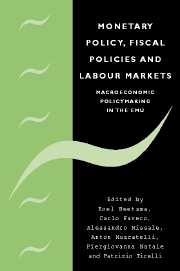Book contents
- Frontmatter
- Contents
- List of figures
- List of tables
- List of contributors
- Acknowledgements
- Editors' introduction
- Part I Monetary policy
- 1 The European Central Bank: a view from across the ocean
- 2 Which measure of inflation should the ECB target?
- 3 An evaluation of alternative targeting rules for the ECB
- 4 Inflation modelling in the euro area
- Part II Fiscal policies
- Part III Labour markets
- Index
2 - Which measure of inflation should the ECB target?
from Part I - Monetary policy
Published online by Cambridge University Press: 22 September 2009
- Frontmatter
- Contents
- List of figures
- List of tables
- List of contributors
- Acknowledgements
- Editors' introduction
- Part I Monetary policy
- 1 The European Central Bank: a view from across the ocean
- 2 Which measure of inflation should the ECB target?
- 3 An evaluation of alternative targeting rules for the ECB
- 4 Inflation modelling in the euro area
- Part II Fiscal policies
- Part III Labour markets
- Index
Summary
Introduction
The ECB has intepreted its mandate for price stability as keeping the inflation of the Harmonised Index of Consumer Prices (HICP) between 0 and 2% per year, in the medium term. Price indexes such the HICP for the euro area are constructed to measure the cost of living and are not necessarily the best target for monetary policy. Two contributions in this part of the book deal with the measure of an appropriate inflation target for the ECB. I shall introduce the issue by first reviewing three years of ECB activity, as seen and judged by different groups of academic ECB watchers. The evidence shows that the uncertainty surrounding estimated econometric relationships is rather high, so high that it is very hard to extract from the data an assessment of the consistency between the deeds and the words of the European Central Bank. In fact, despite its apparently tight formulation, the mandate of the ECB, interpreted in the light of the uncertainty surrounding those relationships among the data relevant to the application of such a mandate, leaves plenty of room for flexibility. In other words, the fact that inflation has been above its target for more than twenty-four months since January 2000 does not lead to the rejection of the null hypothesis that the ECB has not violated its mandate. Some watchers have proposed to deal with uncertainty by choosing inflation of less volatile indexes.
- Type
- Chapter
- Information
- Monetary Policy, Fiscal Policies and Labour MarketsMacroeconomic Policymaking in the EMU, pp. 20 - 30Publisher: Cambridge University PressPrint publication year: 2004



